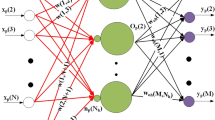Abstract
The universal technique of finding optimum training parameters for multi-layer perceptron—such as percentage of samples in a cross-validation set and quantities of training iterations with various initial values—is offered. This technique is aimed at the searching of optimum values of two complex factors depending on accuracy and convergence of a network, and also on the time of its training. Their conventional names are “cross-validation coefficient” and “training iteration coefficient”. Near infrared spectroscopy data for gasoline samples are used to evaluate the efficiency of the method.






Similar content being viewed by others
References
Côcco LC, Yamamotob CI, von Meien OF (2005) Study of correlations for physicochemical properties of Brazilian gasoline. Chemom Intell Lab Syst 76:55–63. doi:10.1016/j.chemolab.2004.09.004
van Leeuwen JA, Jonker RJ, Gill R (1994) Octane number prediction based on gas chromatographic analysis with non-linear regression techniques. Chemom Intell Lab Syst 25:325–390. doi:10.1016/0169-7439(94)85051-8
Andrade JM, Sánchez MS, Sarabia LA (1999) Applicability of high-absorbance MIR spectroscopy in industrial quality control of reformed gasolines. Chemom Intell Lab Syst 46:41–55. doi:10.1016/S0169-7439(98)00156-7
Yang H, Ring Z, Briker Y, McLean N, Friesen W, Fairbridge C (2002) Neural network prediction of cetane number and density of diesel fuel from its chemical composition determined by LC and GC–MS. Fuel 81:65–74. doi:10.1016/S0016-2361(01)00121-1
Meusingera R, Morosb R (2001) Determination of octane numbers of gasoline compounds from their chemical structure by 13C NMR spectroscopy and neural networks. Fuel 80:613–621. doi:10.1016/S0016-2361(00)00125-3
Rumelhart DE, Hinton GE, Williams RJ (1986) Learning internal representations by error propagation. In: Rumelhart D, McClelland J (eds) Parallel data processing, vol I, Chap. 8. The MIT Press, Cambridge, pp 318–362
Wang W, Paliwal J (2006) Generalisation performance of artificial neural networks for near infrared spectral analysis. Biosyst Eng 94:7–18. doi:10.1016/j.biosystemseng.2006.02.001
Burns JA, Whitesides GM (1993) Feed-forward neural networks in chemistry: mathematical systems for classification and pattern recognition. Chem Rev 93:2583–2601. doi:10.1021/cr00024a001
Balabin RM, Safieva RZ, Lomakina EI (2008) Wavelet neural network (WNN) approach for calibration model building based on gasoline near infrared (NIR) spectra. Chemometr Intell Lab 93:58. doi:10.1016/j.chemolab.2008.04.003
Balabin RM, Safieva RZ (2008) Motor oil classification by base stock and viscosity based on near infrared (NIR) spectroscopy data. Fuel 87:2745. doi:10.1016/j.fuel.2008.02.014
Balabin RM, Safieva RZ (2007) Capabilities of near infrared spectroscopy for the determination of petroleum macromolecule content in aromatic solutions. J Near Infrared 15(Spec):343. doi:10.1255/jnirs.749
Russian Standard: GOST R 51069-97
Moody J, Utans J (1992) Principled architecture selection for neural networks: application to corporate bond rating prediction. In: Moody J, Hanson SJ, Lippmann RP (eds) Advances in neural information processing systems, vol IV. Morgan Kaufmann, San Mateo, pp 683–690
Larsen J, Goutte C (1999) On optimal data split for generalisation estimation and model selection neural networks for signal processing. In: IX Proceedings of the 1999 IEEE signal processing society workshop, pp 225–234
Jurs PC, Bakken GA, McClelland HE (2000) Computational methods for the analysis of chemical sensor array data from volatile analytes. Chem Rev 100:2649–2678. doi:10.1021/cr9800964
Balabin RM, Syunyaev RZ (2008) Petroleum resins adsorption onto quartz sand: near infrared (NIR) spectroscopy study. J Colloid Interface Sci 318:167. doi:10.1016/j.jcis.2007.10.045
Balabin RM, Safieva RZ (2008) Gasoline classification by source and type based on near infrared (NIR) spectroscopy data. Fuel 87:1096. doi:10.1016/j.fuel.2007.07.018
Balabin RM, Safieva RZ, Lomakina EI (2007) Comparison of linear and nonlinear calibration models based on near infrared (NIR) spectroscopy data for gasoline properties prediction. Chemometr Intell Lab 88:183. doi:10.1016/j.chemolab.2007.04.006
Balabin RM, Syunyaev RZ, Karpov SA (2007) Molar enthalpy of vaporization of ethanol–gasoline mixtures and their colloid state. Fuel 86:323. doi:10.1016/j.fuel.2006.08.008
Balabin RM (2008) Dispersed structure of ethanol–gasoline fuel according to dynamic light scattering method. J Dispersion Sci Tech 29:457. doi:10.1080/01932690701718925
Balabin RM, Syunyaev RZ, Karpov SA (2007) Quantitative measurement of ethanol distribution over fractions of ethanol-gasoline fuel. Energy Fuels 21:2460. doi:10.1021/ef070081l
Allen MP, Tildesley DJ (1989) Computer simulation of liquids. Oxford University Press, New York
Balabin RM (2008) Intermolecular dispersion interactions of normal alkanes with rare gas atoms: van der Waals complexes of n-pentane with helium, neon, and argon. Chem Phys 352:267. doi:10.1016/j.chemphys.2008.06.015
Acknowledgments
Balabin Roman is grateful to the ITERA International Group of companies for a nominal scholarship. Authors are grateful to Lumex Ltd. R&D and Production Company (and personally to Demygin SS and Chulyukov OG) for supplying the InfraLUM FT-10 FT-NIR Analyzer.
Author information
Authors and Affiliations
Corresponding author
Rights and permissions
About this article
Cite this article
Balabin, R.M., Safieva, R.Z. & Lomakina, E.I. Universal technique for optimization of neural network training parameters: gasoline near infrared data example. Neural Comput & Applic 18, 557–565 (2009). https://doi.org/10.1007/s00521-008-0213-3
Received:
Accepted:
Published:
Issue Date:
DOI: https://doi.org/10.1007/s00521-008-0213-3




